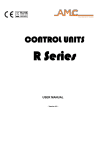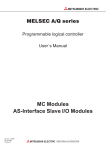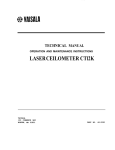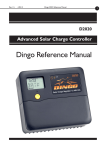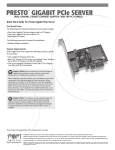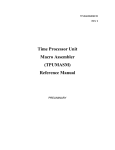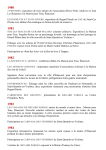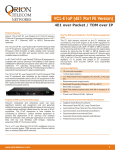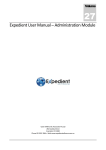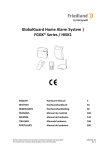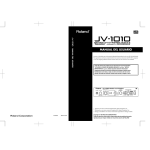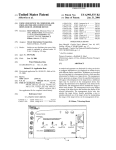Download "user manual"
Transcript
CONTr:NTS
Editorial Note
2
Using Computercards is Hrong
3
Present Availability of PASCAL Compilers
13
Installation Notes
20
Statistics of Computing Installation, September
21
Utilisation by Objectives & Accounts, September
22
Statistics of Batch Processing, September
23
Histogram of Equivalent Time Usage
23
List of Personnel
24
-
1 -
EDITORIAL NOTE.
The Computing Centre Newsletter is publisl1ed monthly exceryt
August and December.
for
It describes developments, modifications and specific topics in
relation to the use of the computing installations of the ,Taint
Research Centre, Ispra Establishment.
The aim of the Newsletter is
to provide information of
importance to the users of the computing installations, in a
form which is both interesting and readable.
The Newsletter also includes articles which are of intellectual
and educational value in order to keep the users informed of new
advances in co~puter science topics.
The Editorial Board is composed as follows:
J.
Pire.
Responsible Editor.
H.
Dowel!.
Technical Editor.
c.
• Pigni.
Editors.
H.
de Wolde.
Administration and contact address:
Us. A. Cambon (tel. 7 30)
Support to Computing
Building 36
J.R.C. Ispra Establishment
21020-ISPRA (Varese)
LEGAL
1~0TICE:
Neither the Commission of the European Communities nor any
person acting on behalf of the Commission is responsible for the
use which might be made of the information in this Newsletter.
- 2 -
USING COMPUTERCARDS IS WRONG
H. I.
da Wolde
As explained in
a previous issue, the exte~sive use of
computercards is wrong, dangerous, old fashionsd, costly, and
bears many perils.
The present computing facilities, although not representing the
latest developments in the field, offer an extensive number of
tools by which the use of punchcards may be avoided.
This article does not contain any new information~ it just
gives, on request of some users, one of the possible solutions
towards program development wi~~ a
very li~ited use
of
punchcards.
Suppose we have to develop a
requires many input data parts.
Furthermore, we have access to
video.
large
a
P.ORTRAN program
which
TSO terminal, preferably a
Librarian
we cho~e the Librarian for the storage of the basic material,
because this system is very well protected against loss or
destruction of information, providing that
the masterfile
manager makes adequate security copies of the information.
Secondly the disk space utilization is very economical and the
material is accessible under TSO and from batch jobs.
If you do not yet have access to a masterfile, you may create
one by using the information presented in example 1.
The description of the available options and the composition of
the reservation card may be found in the Green Book on
Librarian.
It is strongly recommended not to create different masterfiles
for each development but to share the·use of tl1ese files. This
enables the users to have sensible procedures for back-up and
compress and to make the most economic use of the available
space.
For the intended task,
masterfile:
we
need
to create two modules in
the
- Source program
- Input data
ways are open for these tasks, either from punchcards in
processing or by means of a terminal under TSO.
The
second method is the most economic in terms of manpower.
Preparing a deck in punchcards requires roughly three times more
efforts in comparison to transfering the same information by
means of a video terminal. If, however, you have a· big volume
of new data to introduce in the computer, it may be convenient
to rely on the punch service to have them punched on cards.
Two
~atch
- 3 -
A card input deck may be loaded by the job in batch as shown in
example 2. Immediately after a back-up of the file has been
made by the master file manager, the deck should be destroyea.
Otherwise you rnig!1t rely too much on the presence of a card
input deck and cause confusion with new versions of the module.
The equivalent job is performed under TSO by the creation of a
file, under EDIT control, and successively transfer to the
masterfile as the example 3.
Execution
The composition of the deck for
given in example 4.
the execution of
the
job
is
Such a deck may be punched and brought into the input stream by
means of the card reader. However, a TSO SUBMIT can perform the
same task and has some advantages. For example, different types
of errors are detected and reported before the job submission is
accepted by the system. This may save you considerable time.
Now we suppose that you have already created a partitioned data
set, named for example TSOPROC.CNTL, in which only the qualifier
a~TL is obligatory, the first part of
ti1e name may be cho~en
freely. If you don't have such a data set consult the HELP
procedure CREARES.
Create a new member named for example EXEC, of the partitioned
data set using of the Editor:
composition from example 4 but omit the-~nd-t~
•
To place the job in
the command:
the input stream, it
is sufficient to give
SUBMIT TSOPROC.CNTL(EXEC)
Updating
The updating and extension of a
and quicker to perform than
form. Again, many small errors
is placed in the input stream,
the average turn around time.
program under TSO is much easier
the same operation in punchcard
may be detected before the job
which may save you several times
- 4 -
After the LOGON procedure the commands are arranged as follows:
LIBGET PROGA DS('SYSU.name')
EDIT PROGA fortgi
@i ting commands~)
SAVE
~--
END
LIBSAVE
*
In \'IThich PROGA is the assumed ;1arne of the Librarian module. :'le
strongly advise users to issue frequ~ntly o SAVE command during
editing and possibly a r.IBSAV'.?, followe:l by a LIBGET i:1struction
to store the corrections already performed.
In case of an
unexpected shut down of the computer this will save you a great
deal of work. The LIBSAVE command cancels the working copy of
the module, so it has to be f.ollmve:i by a LIBGET command to
continue the updating.
Private Libraries
If you are developing a large program, it is very useful to
store the completed and tested subroutines separately in the
masterfile and as a load module in a private library. In this
way, the active source part of the proqram remains smaller and
might give a considerable saving in CPU time and channel
traffic.
A completed subroutine may be extracted fro~ the source deck,
installed as a separate module and loaded to your private
library, named SYSi.LIBxxxxx, in which xxxxx are characters
which may be chosen by the user. This is performed using the
information given in example 5.
If SUBR1 existed already in the Private Library, the old version
will be substituted by the new one.
The most flexible and
economic way of using this procedure is to load it in the same
partitioned data set as mentioned earlier. ?or exa~ple with the
name TSOPROC.CNTL(LOAD).
Before the submission of this job you have only to modify (under
EDIT control), the name of the subroutine and the related record
numbers.
Then the following command should be given:
SUBHIT
TSOPROC.~NTL(LOAD)
After the successful execution of the job you must cancel the
records n throuqh m in module PROGA to reduce compilation time
and because they are safely stored elsewhere under the name
SUBR1.
- 5 -
Example 6 describes a situation in which the mounting of a tape
is required. The whole procedure may be stored as a member of a
partitioned data set and the following tasks are executed:
- The retrieval of
called PROGA.
the updated parts of
the source program,
- The retrieva·l of the input data, called DATA.
- The compilation of the source.
- The link-editing to include the subroutine .load modules.
- The request for tape mounting.
- The execution of the program.
- 6 -
Example 1
IIJOBLIB
DD
DSN=LIBP.A75,DISP=(SHR,KEEP),UNIT=DISK,
VOL=SER=COPICB
IISTEP1
EXEC PGM=$$URI~~
//SYSPRINT DD
SYSOUT=A
//~ffiSTER
DD
UNIT=DISK,VOL=SER=USERnn,DSN=SYSU.name,
11
DCB= (BLKSIZE=6444 ,DSORG=DA) ,DISP= (NEl'i',CATLG,DELETE) ,
11
SPACE= (CYL, (k))
IISYSIN
DD *
-OPT UNIT,DISK,options
11
I*
IISTEP2
EXEC EURDR,U=DISK,V=USERnn
IIGO.SYSIN DD*
~eservation card:>
I*
In which:
nn
indicates a diskpack of the USER series
name is the second part of the masterfile name
k
is the number of cylinders. One cylinder may contain
about 6000 records of mixed nature.
Options
-OPT
is
a Librarian command card.
The ootions
at
initializing a masterfile are the default definiti~ns for the
whole file.
At the subsequent loading of modules into the
file one may change these default values and define new ones
for the single module.
The most common form is:
-OPT
INIT,DISK,NORESEQ,SEQ=I73,8~10,101,NOLIST,NOPUNCH,NOEXEC
The records are· numbered starting in column 73 with a field
width of 8 columns.
The first sequence number is 10
increased each time by 10.
The modules of this masterfile
If you
are not automatically renumbered after each run.
expect to have input records with 80 columns of information
you may write:
SEQ=I81,8,10,10I, but this may also be done at the module
level.
The option NORESEQ defines no ·automatic updating of the
recordsequence numbers. Using a card with 10 increase, the
programmer can easily see which records have been added
namely ti1e cards numbered with no 10 multiple. Of course, if
you insert more than 9 cards at a single place ~e system
performs some resequencing.
- 7 -
The reservation card is composed as follows:
colu."'liils
1-7
the number of the "fiche d'activite"
9-12
the number of authorization
14-17 the n~er
manager)
of
the
programmer
(masterfile
19-24 the expiration date
26-69 the masterfile name, left adjusted
8,13,18,25 must be left blank
Space on users disks may be reserved only half a year in
advance. To renew the reservation it is sufficient to run
the next job:
//STEP1
EXEC EURDR,U=DISK,V=USERnn
//GO.SYSIN DD *
new reservption card
I*
example 2:
Librarian:
Load a module by cards
//
EXEC LIBRAP,A='SYSU.name',E='USERnn'
//SYSIN DD *
-OPT
-ADD mname,LIST
-DESC •••••
-PGMR •••••
cards
-EMOD
-END
/*
In which:
nn
indicates a dislcpack of the USER series
name is the name to be given to the new module.
- 8 -
Example 3:
Example of the tra.'lsfer
masterfile( using TSO ) •
of
a
new
module
to
the Librarian
LIBSAVE mname FORT DS('SYSU.name') PGMR(author) DBSC(' ••••• ')
In which:
mname is the module name without qualifiers
name
is the second part of the masterfil~ nama
author is the name of the programmer.
(Don't forget
to always use the same notation!)
DESC(' ••• ') specifies up t0 36 characters of description.
The
masterfile name
apostrophes.
and
the description must
be
enclosed
wi~~in
Once the source program and the input data have been loaded, we
may execute the program, assuming that we do not yet need tapes
or additional files.
Example 11:
Librarian:
deckcomposition for compilation and execution
// •••• JOB ••••
$
Tnm -$
LINES -$
CLASS 2
//STEP1
EXEC LIBRAP,A='SYSU.name',E='USERnn'
//SYSIN
DD *
-OPT
-SEL,PROGA,EXEC
-EMOD
-END
I*
//STEP2
EXEC LIBRAP,A='SYSU.name',E='USERnn'
//SYSIN
DD *
-OPT
-S~L DATA,EXEC
-EMOD
-END
I*
//STEP3
EXEC FTG1CLG
//CMP.SYSIN DD DSN=*.STEP1.INS.OSJOB,DISP=(OLD,DELETE)
//GO.SYSIN DD DSN=*.STEP2.INS.OSJOB,DISP=(OLD,DELETE)
In which:
PROGA is the name of the source module
DATA is the name of the data module
nn
indicates a dispack of the USER series
name is the second part of the masterfile name
- 9 -
Example 5:
Load a subroutine from Librarian into the Private Library
// •••• JOB CARD ••••
$
TIME -$
LINES -$
CLASS 2
//STEP1 EXEC LIBRAP,A='SYSU.name',E='USERnn'
//SYSIN DD *
-OPT UTILITY
-OPT
-ADD SUBR1,EXEC
-DESC •••••
-PGMR •••••
-INC PROGA,n,m
-EMOD
-END
I*
//STEP2 EXEC LIBRAP,A='SYSU.name',E='USERnn'
//SYSIN DD DSN=*.STEP1.INS.OSJOB,DISP=(OLD,DELETE)
//STEP3 EXEC FTG1C
//CMP.SYSIN DD DSN=*.STEP2.INS.OSJOB,DISP=(OLD,DELETE)
//STEP4 EXEC FTL,NC=NCAL
//liKED-.SYSLMOD DD DSN=SYS1.LIBxxxxx,UNIT=DISK,
//VOL=SER=USERkk,DISP=(OLD,KEEP)
//LKED.SYSLIN DD DSN=&~OADSET,DISP=(OLD,DELETE)
//
DD *
NAME SUBR1 (R)
I*
In which:
SUBR1
is the name to be given to the subroutine which has
to be added to the private library
PROGA
is the name of the source mOdule containing the
program
n,m
are respectively the first and the last record number
of SUBR1 in the program module PROGA
USERnn is the program module PROGA
1
USERkk is the volume where the private library resides
name
is the second part of the masterfile ~ame
LIBxxxx is the name of the private library to be used
- 10 -
Example 6:
·Source from Librarian, compile and link with Private Library.
// •••• JOB CARD ••••
TIME -LINES -$
CLASS -,$0C TP9=EUtttt,yyy ,zzz
//STEPL_ EXEC LI-BRAP-,A=.LSYStJ;name-. ,E='USERnn'
//SYSIN DD *
-OPT
-SEL PROGA,EXEC
-EMOD
-END
$
$
I*
//STEP2 EXEC LIBRAP.A='SYSU.name',E='USERnn'
//SYSIN DD *
-OPT
-SEL DATA,EXEC
-EMOD
-END
I*
//STEP3 EXEC FTG1CLG,P~~=xxxxx,VLB=USERkk,ULB=DISK
//CMP.SYSIN DD DSN=*.STEP1.INS.OSJOB,DISP=(QLD,DELETE)
I /GO.FTaaFoo1 DD ~~aoe descriptiol'l)
//GO.SYSIN
DD ~.STEP2.INS.oSJOB;DISP=(OLD,DELETE)
In which:
is the tape volume serial number
EUtttt
yyy
is SL or NL
is Y or N (file protection ring)
zzz
SYSU.name is the name of the masterfile
USERnn
is the volume where the masterfile resides
is the source module name
PROGA
is the data module name
DATA
XXX XX
is the last part of the name of the private library
which has full name SYS1.LIBxxxxx
is the volume where the private library resides
USERkk
is the FORTRAN unit name definition.
aa
When the us~r stores this procedure as a member of a partitioned
data set for example: TSOPROC.CNTL(EXEC), one single command
will put the job in the input stream:
SUBMIT TSOPROC.CNTL(EXEC)
- 11 -
References:
1] ·T. S. 0.
HELP procedures
2] Installation Notes (JER)
3]
Green Book:
Librarian
11] Newsletter--No 2
i>fi-vat.e--l'rogram....Li.brari.es
No 111 IBM Time Sharing option,
concepts features & facilities
No 21 The Librarian TSO interface now
in use.
- 12 -
PRESENT AVAILABILITY OF PASCAL CQr'!PILERS
A. A. Pollicini
There has been a PASCAL compiler installed on t:1e ra~~ 370/165 of
the JRC-Ispra Computing Centre since Septe~er 1977.
This compiler originated from the Inforrnatics Departnent of !REP
at Grenoble University.
The release at present installed is H2.04.00, update (78 •• 33).
[ 1]
The compiler can be accessed in batch by invoking one of the
following catalogued procedures and requires 300 kbytes of core.
A) Compilation and module editing
//LOAD
EXEC PASCL
//CMP.INPUT
DD *
source program
/*
//LKED.SYSLMOD DD UNIT=DISK,VOL=SER=USERxx,DISP=MOD,
//
DSN=MYLIB(MYPROG)
Where the generic names "MYLIB" and "MYPROG" stand for a user
library and a user program respectively.
USERxx should be replaced by the name of the appropriate user
volume on which the library U-iYLIB) is stored.
The user program is now stored
and may be executed as follows:
~n
load form
on
//XPR
EXEC PGM=MYPROG
//STEPLIB DD UNIT=DISK,VOL=SER=USERxx,
//
DSN=MYLIB,DISP=SHR
//OUTPUT DD SYSOUT=A,DCB=(RECFH=FA,BLKSIZE=133)
//INPUT
DD
input data
*
I*
B) Compilation, module editing and execution
//RUN
EXEC PASCLG
DD
source program
*
//C~.INPUT
I*
*
//GO.INPUT DD
input data
I*
- 13 -
the library
A new PASCAL compiler for IBM computers was obtained this year
from the Australian Atomic Energy Commission [2] and has
recently been installed.
Two catalogued procedures have been designed to access the
compiler in batch. The core requirement is 200 kbytes.
AA) Compilation only
//COMP EXEC APASC
//CMP.SYSIN DD
source program
*
/*
BB) Compilation, module editing and execution
//RUN
EXEC APASCLG
//CMP.SYSIN DD
source program
//GO.SYSIN DD *
input data
*
I*
Notice that the compiler returns a completion code greater
than zero only if it cannot compile the source. Therefore,
in the case of syntax errors the returned code is zero (as
well as in the case of successful compilation). For this
reason during program development it is advisable to use the
procedure APASC.
•
Copies of the reference manual of the AAEC PASCAL compiler may
be purchased at the Computing Support Library (Mrs. Cambon
bld. 36).
- 14 -
GENERAL CONSIDERATIONS
Unfortunately, in the PASCAL world, portability problems are
more important than users might expect for such a widely
available programming language.
Although the original definition of pro£. Wirth [3] was always a
fixed reference for any implementor, the standardization of the
language by official bodies has only been recently started. The
first draft was published this year [4].
This may explain why
the two implementations present a number of incompatibiiities
reviewed in the following:
The first point is related to a different use of some special
characters.
In fact the original character set of the language includes some
symbols outside the ones allowed by the EBCDIC set: It is usual
to replace them by combination of symbols, but 1n some case
there is a lack of uniformity as shown . in table I.
'
PASCAL
REPORT
!REP
Compiler
AAEC
Compiler
USE
f
J
(*
*l
(*
*l
Comments
[
l
(
) (a)
or
>I Cbl
(.
.
Arrays (a) and
I<
t
"
)
sets (b)
@
TABLE I
- 15 -
pointers
A second point requ~r~ng care is the use of I/O statements and
procedures, for which the situation is su>nmarize:J. in Table II.
fillEc
PASCAL REPORT
IREP
INPUT and OUTPUT
fil8S declared in
the PROGRAM.
statement
INPUT and OUTPUT
to be declared as
FILE OF
in the
context of the
source program
as in the REPOR'f
RESET cannot apply
on INPUT fil·3~
REWRITE cannot
apply on OUTPUT
file
RESET a::>plies on
INPUT and REt~ITE
on OUTPU'f
as in the REPORT
COMPI~l!:f.l.
...
-
EOLN (file)
PAGE (file)
PAGE (file)
predefined
I~OL' EOP
-
COMPILER
E0LN (file)
-
constant~
.
TABLE II
As an example, write COLil.'Tiands on a line printer may occur in one
among the following alternatives.
A_a.::;C compiler
IREP compiler
WRlTELN ( ••• ) ~
WRITE ( ••• ,EOL) ~
WRITE( ••• ) ~WRITE (EOL)
~
"I'TRITEL~~ ( ••• ) ~
WRITELN ( ••• ) ~
WRITE ( ••• ) ~WRITELU~
Moreover, the control of pagination is performed in
implementation in the following ways:
WRITE( ••• , •••
,EOP)~
or
the
IREP
WRITE( ••• , •.• ) ~PAGE(OUTPUT)~
On the contrary the AAEC comoiler makes use of the ASA contro1
characters as first character of each line as in FORTR&~ FORMAT.
Additionally PACKED ARRAY is allowed in the AAEC compiler and
the standard keyword SET is used instead of POWERSET.
- 16 -
These comparisons do not cover all the differences between e1e
two implementations, but are given to warn users about the need
for careful reading of e1e specific reference manuals, before
using either of the compilers.
As a conclusion of _ the present announcement a short example
coded accordingly to the AAEC implementation is shown in
Appendix 1.
REFERENCES
[1] FAUCHE,JP.; HENNERON,G.; TASSART,G.
Complements au "PASCAL User Manual and Report" concerna"nt
l'implem~ntation du Compilateur PASCAL, realisee par l'IREP.
!REP - Universite des Sciences Sociales de GRENOBLE (1977)
[2] COX,G.W.; TOBIAS,J.M.
PASCAL 8000 IBM 360/370 version for OS and
Version 1.2 Reference Manual
Australian Atomic Energy Commission (1978)
VS environments.
[3] JENSEN,K.; WIRTH,N.
PASCAL User Manual and Report
Springer-Verlag (2nd edition) (1978)
[4] ADDYMAN,A.M. et al.
A DRAFT DESCRIPTION OF PASCAL
Software practice and Experience pp. 381-424
- 17 -
Vol. 9,
n. 5 (May 1979)
APPENDIX 1.
Exruuple of
a
implementation
PROGRAM
PASCAL
program
according
to
the
AAEC
WHATi>AY (INPUT,OUTPUT )1
(* THE INTENT OF THIS PASCAL PROGRAM IS
TO
S A Y
WH A T
D A Y
OF THE WEEK IS
ASSOCIATED TO A DATE SPECIFIED BY THREE INTEGERS
IN THE ORDER I DAY I I MONTH I I YEAR I •
EACH DATE IS EXPECTED ON A SEPARATE INPUT RECORD. *)
CONST NULL = 0 1
TYPE DAYOFWEEK =PACKED ARRAY(.1 •• 9.) OF CHAR1
VAR
DAY: DAYOFi'lEEK1
DATE,MONTH,YEAR,MM,YY,CC:.INTEGER1
PROCEDURE FINDDAY1
(* PLEASE DON'T WORRY ABOUT THIS OBSCURE ALGORITHM! *)
VAR
PRM1,PRM2,PRM3,PRM4,0RDER: INTEGER1
BEGIN
PRM1:= (13*MM-1) DIV S1
PRM2:= YY DIV 41
PRM3:= CC DIV 41
PRM4:= Pffi11+PRM2+PRM3+DATE+YY-2*CC1
ORDER:= PRM4 MOD 71
IF ORDER<NULL THEN ORDER:= ORDER+71
CASE ORDER OF
0
DAY:= 'SUNDAY
'1
1
DAY:= 'MONDAY
'1
2
DAY:= 'TUESDAY '1
3
DAY:= 1 WEDNESDAY 1 1
4
D~Y:= 'THURSDAY '1
5
DAY:= 'FRIDAY
I 1
6
DAY:= 'SATURDAY I
END
END1 (* FINDDAY *)
BEGIN
WHILE NOT EOF(INPUT)
DO
BEGIN
READLN( DATE,MONTH,YEAR )1
CC:= YEAR DIV 1001 YY:= YEAR MOD 1001
IF MONTH)2 THEN MM:= HONTH-2
ELSE BEGIN MM:= MONTH+101
IF YY>NULL THEN YY:= YY-1
ELSE BEGIN CC:= CC-11 YY:= 99 END
END1
FINDDAY1
WRITELN ( 1 0 THE DAY ASSOCIA'rED TO 1 ,
DATE:2,'.',MONTH:2;'.',YEAR:4,
I
IS ',DAY:10)
END1
WRITELN ( I 0 BND OF DATA I ) 1
END. (* WHATDAY *)
- 18 -
EXAMPLE DATA.
12
9
7
29
10
5
4
2
1492
1956
1959
1980
RESULTS.
THE
THE
THE
THE
END
DAY ASSOCIATED
DAY ASSOCIATED
DAY ASSOCIATED
DAY ASSOCIATED
OF DATA
TO 12.10.149'2 IS WEDNESDAY
TO 9. 5.1956 IS WEDNESDAY
TO 7. 4.1959 IS TUESDAY
TO 29. 2.1980 IS FRIDAY
- 19 -
INSTALLATION NOTES (JOB REQUESTS STATEl{BNTS).
In order to reflect the introduction of the new $OC control
cards in the HASP system(see Newsletter 34 -September 1979 for
details), one new section for the installqtion notesCJER) has
been added and two of the existing sections(INFO and UTIL) have
been updated.
To obtain copies of these installation notes
users should consult the information in Newsletter 28 - February
1979 pages 6 and 7.
To list the JER(Job Execution Requirements) section it is
necessary to request only 1000 lines of printed output(i.e 111
should be 001 ).
An example of
below:
the job necessary to list the
// ••••••••• JOB(your job card) •••
$
LINES 001
//
EXEC LIHNO,MEMB=JER
- 20 -
JER notes is given
Statistics of computing installation utilization.
Report of computing installation exploitation
for the month of
September
1979.
Yi'!AR 1978
YI!AR 1979
21
d
16.0011
18.00h
3.91h
21.91h
314.09h
138.85h
20
d
16.00h
18.1Bh
18.35h
36.53h
283.47h
130.27n
7914
1919000
25387000
121000
132.11h
15012000
3841000
6369
1154800
13836000
70800
114. 14h
198761)00
3236000
1313
551i11
285194
4.82h
687000
631.34h
2487
156243
861517
14. 11h
2364000
1709.99h
381.40h
1. 92h
336000
264.29h
2.02h
655900
General
Number of working days
Work hours from 8.00 to 24.00 for
Duration of scheduled maintenance
Duration of unexpected mainten.;nce
Total maintenance time
Total exploitation time
CPU time in problem mode
ilatch Processing
Number of
Number of
Number of
Number of
CPU time
Number of
Number of
jobs
cards input
lines printed
cards punched
I/O {Disk)
I/O {Magnetic tape)
T.S.O
Number of LOGON's
Number of messages sent by terminals
Number of mess<t'J'"; receiv9d by terminals
CPU time
Number of I/O {Disk)
Connect time
~
Total time service is available
CPU time
Number of I/O {Disk)
- 21 -
Utilisation of computer centre by objectives
and appropriation
accounts for the month of September 1979
IBH 370/165
equivalent time in hours
1.20.2
General Services- Administration- Ispra
1.20.3
General Services- Technical- Ispra
0. 11
1 • 30. 3
Central Workshqp
2. 17
1.30.4
L.M.A.
1.90.0
ESSOR
1.92.0
Support to the Commission
2.10.1
Reactor Safety
2.10.2
Plutonium Fuel and Actinide Research
2.10.3
Nuclear Materials
2.20.1
Solar Energy
0.07
2.20.2
Hydrogen
0.25
2.20.4
Design Studies on Thermonuclear Fusion
18.52
2.30.0
Environment and Resources
22.11
2.40.0
METRE
2. 50. 1
Infor::natics
2.50.~
Training
2.50.]
Safeguards
41.39
2.43
98.82
13. 17
2.60
35.86
8.82
TOTAL
1.94.0
Servic~s
31.62
to External
U~qrs
3.54
TOTAL
- 22 -
277.94
281.48
BATCH PROCESSING DIST;U3:JT3;:J BY REQUESTED CORE MEMORY SIZE
100
300
200
6·JO
1100
No. of jobs 1752 2052 10111 820 319
Elapse;i time
95
76 127 127 153
CPU ti"le
3.3 17.5 22.6 24.1 29.7
".C:quiv" ti::ne
23
39
116
38
63
"Turn" time
0.11 1.0 1.5 2.11 3.3
2014 2055 3266 5271 11111
I/0 (disk)
1987 381 202 600
3
I/0 tape)
800 1000 12:).) 11100
25
13
11
10
..
ll.'l
,
6
3.2
207
5
6.2
211
-
-
:)
18
13
11.2
'> 140 0
-
22
9
-
2.7
4
4.0
1811
2
7
4.3
335
18
-
--
NOTE.
All times are in hours.
"Equiv" means equivalent.
"Turn" means turn around.
All I/O transfers are measured in 1JOO's.
PERCE.:l'l'AGE OF JOi:lS FINISHED IN LESS
T _,u:;
15rm 30mn 1hr
%year 1973
THAl~'
2hrs 4hrs 8hrs 1day 2day 3day 6da.z
311
52
69
811
96
98
99
100
100
100
35 1
32
~5
80
93
99
100
10J
101)
100
--·
%year 1C!79
'1ISTOGRI:l!1
or
TOTAL [QUIVALEN'!' '!'It1Et'iRSl
==:I
-
iSO
.!Ill
fEll
'RIIP.IIIIYJIIIJlLIIJFliEI'OCTIItii!JU:
Projected total for 1979 = 3245 hours (using avera·:p).
Total for 1978 was
= 3253 hour~.
- 23 -
iillFEREHCES TO THE PERSONNEL/FUIICTIONS OF THE COUPUTING CENTRE.
~lanaqer
J.Pire
of The Computing Centre
Ms. G.Rambs
Responsible for User Registration
Operations Sector
Responsible for the Computer Room
Substituted in case of abscence by:
A.Binda-Rossetti
G.Nocera
Responsible for Peripherals
Systems Group
Responsible for the group
Substituted in case of abscence by:·
o.Konig
P.A.Moinil
C.Daolio
Responsible for TSO Registration
Room Tele.
Informatics Support Sector
Responsible for the Sector
1833
1259
1873
787
1883
1259
ltrs. A.Cambon
1~71
730
Advisory Seryice/List of Consultants(See Uote 1)
1870
730
(f.f.-} H.de
~volde
Hrs. G.Hudry
Secretary
H.de Wolde
Responsible for User Support
General Inf./Support Library
A.A.Pollicini
A.Inzaghi
H.I. de Wolde
M.Dowell
R.Meelhuysen
NOTE 1. The advisory service is available in. the same room ~s
the Computing Support Library(room 1870). Exact details of the
advisory service times for a specific week can be found at tae
head of any output listing(for t~at week).
Any informatics problem may be raised. However, the service is
not designed to help users with problems which are their sole
responsibility. For example, debugging of the logic of programs
and requests for info~tion which can easily be retrieved from
available documentation.
·
If necessary, other competent personnel from the informatics
division ma~ be contacted by the consultant but not directly by
the users.
The users should only contact ~1e person who is the consultant
for that specific d~y and only during the specified hours.
Outside
the specified
hours general infon~ation may be
requested
from
Mrs. A. Cambon in
the Computing Support
Library.
-
24 -
HOW TO BECOME A REGULAR READER OF Till! NEWSLE'l'TER.
Persons
intere~;~ted
Newsletter" are
in receiving regularly the "Computing Centre
requested
to
fill in the following for.u
send it to :-
Ms. A.
Cambon
Support To Computing
Building 36
Tel. 730.
Please add me to the Newsletter mailing list.
NAHE
ADDRESS
TELEPHONE
and





























